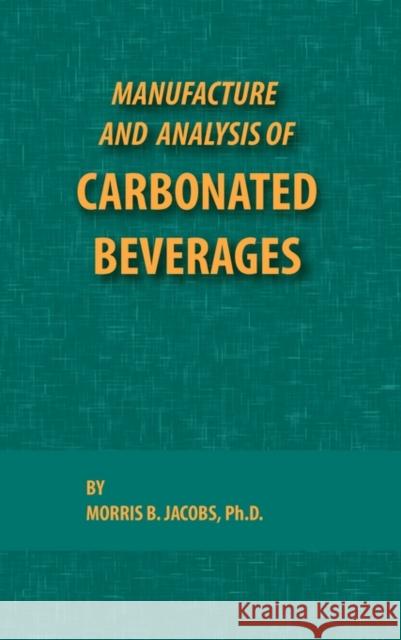Manufacture and Analysis of Carbonated Beverages » książka
Manufacture and Analysis of Carbonated Beverages
ISBN-13: 9780820600123 / Angielski / Twarda / 1959 / 338 str.
CONTENTS - INTRODUCTION - 2. SUGARS AND SYRUPS - 3. ARTIFICIAL AND HIGH-POWER SWEETENING AGENTS 4. ACIDS AND ACIDULATION - 5. WATER AND WATER TREATMENT - 6. FLAVORS AND FLAVORING - 7. SPECIALTY AND FRUIT FLAVORS - 8. EMULSIONS AND SPECIALTIES - 9. COLORS AND COLORING - 10. CARBON DIOXIDE AND CARBONATION - 11. BOTTLING AND CANNING - 12. COMPOSITION OF CARBONATED BEVERAGES - 13. PLANT LAYOUT AND SANITATION - 14. SPOILAGE - 15. CHEMICAL ANALYSIS - INDEX - PREFACE - In this book I have endeavored to present a comprehensive treatment of the manufacture and analysis of carbonated nonalcoholic beverages or carbonated soft drinks as they are commonly called. Each category of the raw materials used in these beverages is considered, namely, sugars and sirups, artificial sweetening agents, acids, water, flavors and flavoring, including specialty and fruit flavors and also flavor emulsions both of the clear and cloudy type, colors and coloring, and carbon dioxide. The actual manufacturing steps are described in detail in the chapter on bottling and canning and, in this connection, bottle washing, caustic solution preparation, plant layout, plant housekeeping, and sanitation are discussed in detail. The composition of the finished beverages by categories is considered. The various types of spoilage that may occur and the means for the prevention of such spoilage are treated in another chapter. Finally the methods of analysis both for control during manufacture and for the determination of composition are detailed. I acknowledge with thanks the cooperation given to me by the American Bottlers of Carbonated Beverages and by several firms. These acknowledgements are given specifically in the text. It may be noted that reference is made to American Bottlers of Carbonated Beverages, the United States Pharmacopeia, and the National Formulary standards and specifications for a number of raw materials. These agencies speak for themselves and their standards are quoted merely as guides for desirable practice. Some beverage, flavor, and color formulations are listed in this book. Some of the compositions mentioned are illustrative of commercial practice while others are of an experimental nature. These formulas have been included to serve as suggestions to the manufacturer; they are not given as a formulary. The application of knowledge of the art and skill may result in the improvement of these formulations. The mention of a particular substance in this book does not in any manner imply that I approve of the use of such a substance.
CONTENTS -INTRODUCTION - 2. SUGARS AND SYRUPS - 3. ARTIFICIAL AND HIGH-POWER SWEETENING AGENTS 4. ACIDS AND ACIDULATION - 5. WATER AND WATER TREATMENT - 6. FLAVORS AND FLAVORING - 7. SPECIALTY AND FRUIT FLAVORS - 8. EMULSIONS AND SPECIALTIES - 9. COLORS AND COLORING - 10. CARBON DIOXIDE AND CARBONATION - 11. BOTTLING AND CANNING - 12. COMPOSITION OF CARBONATED BEVERAGES - 13. PLANT LAYOUT AND SANITATION - 14. SPOILAGE - 15. CHEMICAL ANALYSIS - INDEX - PREFACE - In this book I have endeavored to present a comprehensive treatmentof the manufacture and analysis of carbonated nonalcoholicbeverages or carbonated soft drinks as they are commonly called.Each category of the raw materials used in these beverages is considered,namely, sugars and sirups, artificial sweetening agents,acids, water, flavors and flavoring, including specialty and fruitflavors and also flavor emulsions both of the clear and cloudy type,colors and coloring, and carbon dioxide. The actual manufacturingsteps are described in detail in the chapter on bottling and canningand, in this connection, bottle washing, caustic solution preparation,plant layout, plant housekeeping, and sanitation are discussedin detail. The composition of the finished beverages by categoriesis considered. The various types of spoilage that may occur and themeans for the prevention of such spoilage are treated in anotherchapter. Finally the methods of analysis both for control duringmanufacture and for the determination of composition are detailed.I acknowledge with thanks the cooperation given to me by theAmerican Bottlers of Carbonated Beverages and by several firms.These acknowledgements are given specifically in the text. It may benoted that reference is made to American Bottlers of CarbonatedBeverages, the United States Pharmacopeia, and the NationalFormulary standards and specifications for a number of raw materials.These agencies speak for themselves and their standards arequoted merely as guides for desirable practice.Some beverage, flavor, and color formulations are listed in thisbook. Some of the compositions mentioned are illustrative of commercial practice while others are of an experimental nature. These formulas have been included to serve as suggestions to the manufacturer;they are not given as a formulary. The application ofknowledge of the art and skill may result in the improvement ofthese formulations.The mention of a particular substance in this book does not inany manner imply that I approve of the use of such a substance.











